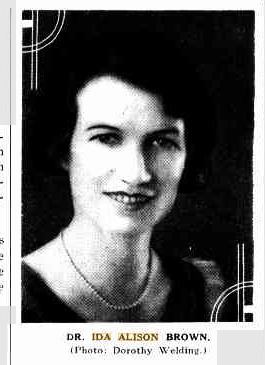Nationality Australian | Occupation Geologist | |
 | ||
Full Name Ida Alison Brown Died 21 October 1976, Edgecliff, Sydney, Australia | ||
Ida Alison Browne (1900–1976) was an Australian geologist and palaeontologist at the University of Sydney.
Contents
Early life and education
Ida Alison Brown was born 16 August 1900 in Paddington, Sydney, New South Wales. She was educated at Fort Street Girls' High School, and went on to study her B.Sc. at the University of Sydney, graduating with Honours, winning the University medal in geology and the Deas Thomson scholarship in 1922.
Career
Giving up the scholarship in 1922 at the request of Professor Edgeworth David, she worked as a demonstrator in geology and petrology at the University until 1927, and researched the minerals of Broken Hill and geology of the south coast of New South Wales. After being awarded a Linnean-Macleay Fellowship from 1927-1931 she further worked on the geology of this region, undertook extensive mapping, travelled overseas visiting research institutes and attending scientific congresses.
Brown took her D.Sc. in 1932, the second woman to do so at the University of Sydney, and then found work hard to find. She was unable to work for mining companies because women were forbidden from working underground. She again worked as a demonstrator until 1934, when she became Assistant Lecturer in palaeontology, following the illness of W.S. Dun. She spent considerable time developing her knowledge of palaeontology to the exclusion of other geological research, as well as carrying a full teaching load. Brown was promoted to full lecturer in 1940, and published a paper on the fossiliferous Silurian and Devonian sequences of the Yass district with Germaine Joplin, in 1941. She attempted to work with colleague, Dorothy Hill from the University of Queensland to publish internationally, but mainly focused on Australian publications and her teaching responsibilities. Moving from hard rock to soft rock studies, Brown's research evolved into the study of Palaeozoic invertebrates, specifically brachiopods, as well as stratigraphical studies. Her mapping skills were praised, and her Taemas map continues to be of use. She became a Senior Lecturer in 1945, but like many women, Ida Brown resigned from teaching in 1950, with her marriage to fellow geologist and colleague, William Rowan Browne.
Later life
William and Ida Browne worked from their home residence, undertaking fieldwork when required up until 1965. She published ten papers after her marriage to Browne. She assisted him on his field trips to Kosciusko and he assisted her on field trips to Yass and other regions of New South Wales. She was a member of the Royal Society of New South Wales and Linnean Society of New South Wales, and was the first woman president of the Linnean Society in 1945. She was Vice President of the Royal Society of New South Wales from 1942–1950, Honorary Editorial Secretary from 1950–1953 and first woman President in 1953. She was a member of the Australian National Research Council, ANZAAS and Geological Society of Australia. She was a generous donor of books to the Australian Museum and University of Wollongong libraries. She also supported the creation of the William Rowan Browne medal to honour her husband's legacy.
Browne suffered from a paralysing illness from 1970 and died 21 October 1976 in Edgecliff, New South Wales. Her husband had predeceased her the previous year.
